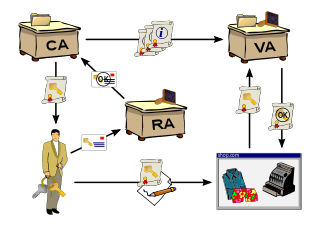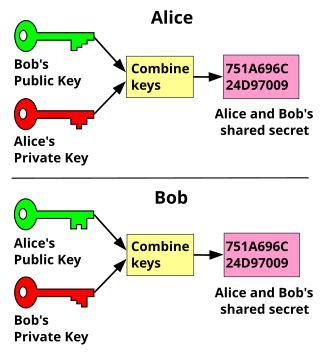
Kerberos is a computer-network authentication protocol that works on the basis of tickets to allow nodes communicating over a non-secure network to prove their identity to one another in a secure manner. Its designers aimed it primarily at a client–server model, and it provides mutual authentication—both the user and the server verify each other's identity. Kerberos protocol messages are protected against eavesdropping and replay attacks.

Public-key cryptography, or asymmetric cryptography, is the field of cryptographic systems that use pairs of related keys. Each key pair consists of a public key and a corresponding private key. Key pairs are generated with cryptographic algorithms based on mathematical problems termed one-way functions. Security of public-key cryptography depends on keeping the private key secret; the public key can be openly distributed without compromising security.
A key in cryptography is a piece of information, usually a string of numbers or letters that are stored in a file, which, when processed through a cryptographic algorithm, can encode or decode cryptographic data. Based on the used method, the key can be different sizes and varieties, but in all cases, the strength of the encryption relies on the security of the key being maintained. A key's security strength is dependent on its algorithm, the size of the key, the generation of the key, and the process of key exchange.

A digital signature is a mathematical scheme for verifying the authenticity of digital messages or documents. A valid digital signature on a message gives a recipient confidence that the message came from a sender known to the recipient.

A public key infrastructure (PKI) is a set of roles, policies, hardware, software and procedures needed to create, manage, distribute, use, store and revoke digital certificates and manage public-key encryption.
In cryptography, X.509 is an International Telecommunication Union (ITU) standard defining the format of public key certificates. X.509 certificates are used in many Internet protocols, including TLS/SSL, which is the basis for HTTPS, the secure protocol for browsing the web. They are also used in offline applications, like electronic signatures.

In cryptography, a certificate revocation list (CRL) is "a list of digital certificates that have been revoked by the issuing certificate authority (CA) before their scheduled expiration date and should no longer be trusted".
In cryptography, a certificate authority or certification authority (CA) is an entity that stores, signs, and issues digital certificates. A digital certificate certifies the ownership of a public key by the named subject of the certificate. This allows others to rely upon signatures or on assertions made about the private key that corresponds to the certified public key. A CA acts as a trusted third party—trusted both by the subject (owner) of the certificate and by the party relying upon the certificate. The format of these certificates is specified by the X.509 or EMV standard.
In computer security, challenge-response authentication is a family of protocols in which one party presents a question ("challenge") and another party must provide a valid answer ("response") to be authenticated.

Key exchange is a method in cryptography by which cryptographic keys are exchanged between two parties, allowing use of a cryptographic algorithm.
The Encrypting File System (EFS) on Microsoft Windows is a feature introduced in version 3.0 of NTFS that provides filesystem-level encryption. The technology enables files to be transparently encrypted to protect confidential data from attackers with physical access to the computer.
Key management refers to management of cryptographic keys in a cryptosystem. This includes dealing with the generation, exchange, storage, use, crypto-shredding (destruction) and replacement of keys. It includes cryptographic protocol design, key servers, user procedures, and other relevant protocols.
SILC (Secure Internet Live Conferencing protocol) is a protocol that provides secure synchronous conferencing services (very much like IRC) over the Internet.
Encryption software is software that uses cryptography to prevent unauthorized access to digital information. Cryptography is used to protect digital information on computers as well as the digital information that is sent to other computers over the Internet.

A hardware security module (HSM) is a physical computing device that safeguards and manages secrets, performs encryption and decryption functions for digital signatures, strong authentication and other cryptographic functions. These modules traditionally come in the form of a plug-in card or an external device that attaches directly to a computer or network server. A hardware security module contains one or more secure cryptoprocessor chips.
Multimedia Internet KEYing (MIKEY) is a key management protocol that is intended for use with real-time applications. It can specifically be used to set up encryption keys for multimedia sessions that are secured using SRTP, the security protocol commonly used for securing real-time communications such as VoIP.
There are a number of security and safety features new to Windows Vista, most of which are not available in any prior Microsoft Windows operating system release.

Cryptography, or cryptology, is the practice and study of techniques for secure communication in the presence of adversarial behavior. More generally, cryptography is about constructing and analyzing protocols that prevent third parties or the public from reading private messages. Modern cryptography exists at the intersection of the disciplines of mathematics, computer science, information security, electrical engineering, digital signal processing, physics, and others. Core concepts related to information security are also central to cryptography. Practical applications of cryptography include electronic commerce, chip-based payment cards, digital currencies, computer passwords, and military communications.
IEC 62351 is a standard developed by WG15 of IEC TC57. This is developed for handling the security of TC 57 series of protocols including IEC 60870-5 series, IEC 60870-6 series, IEC 61850 series, IEC 61970 series & IEC 61968 series. The different security objectives include authentication of data transfer through digital signatures, ensuring only authenticated access, prevention of eavesdropping, prevention of playback and spoofing, and intrusion detection.
IMS is a set of specifications to offer multimedia services through IP protocol. This makes it possible to incorporate all kinds of services, such as voice, multimedia and data, on an accessible platform through any Internet connection.







